03 Others
Trimethoprim/sulfamethoxazole
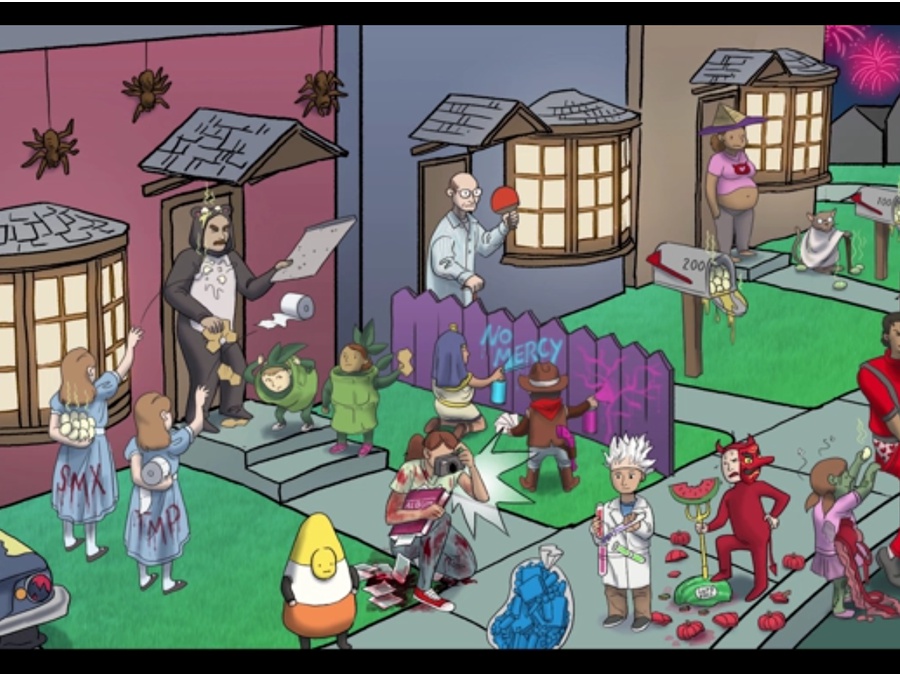
Panda: PABA - intermediate in folate synthesis (foliage for folate)
2 leaves on first step: dihydrofolic acid
4 leaves on second step: tetrahydrofolic acid
Rotten sulfa eggs: sulfamethoxazole (SMX)
Panda dropping: SMX is a PABA analog that blocks dihydropteroate synthase
Toilet paper: trimethoprim (TMP)
2 leaves ducking: TMP blocks dihydrofolate reductase
bacteriocidal when together

Bladder cup: first line treatment for UTI
Egg down pants: treats acute prostatitis
Zombie guts: treats gastroenteritis caused by gram negative bacteria (e.g. Shigella, Salmonella)
Red porta potty: activity against gram negative GI and urinary tract bacteria
No mercy pharaoh: activity against MRSA
Card dealing cowboy: activity against nocardia
Purple fence: activity against gram positive bacteria
Old ping pong man in PJs: treats Pneumocystis jirovecii pneumonia (PJP) (old man: cane for inmmunocompromised)

Address 200: PJP prophylaxis for CD4 < 200
Address 100: toxoplasmosis prophylaxis with TMP/SMX for CD4 <100

Empty pan: pancytopenia
Red fireworks: megaloblastic anemia
Tarantula: teratogen in 1st trimester - antifolate effects cause neural tube defects
Sweaty itchy red devil: sulfa allergy - fever, urticaria, rash
Bite and seeds: bite cells and Heinz bodies seen in RBCs
Broken G6PD-free fruit: hemolytic anemia in G6PD deficiency
Red mask sloughing off: Stevens-Johnson syndrome
Mad scientist with 4 tubes of acid: Type IV renal tubular acidosis (RTA)
K shape: Type IV RTA leads to hyperkalemia
Kidney bag with little blue candies: interstitial nephritis
Flash photo: photosensitivity
Yellow candy corn: kernicterus in neonate (sulfonamide use in last month of pregnancy) (displace bilirubin bound to albumin, increase free unconjugated bilirubin)
Bloody: warfarin displaced from albumin causes over- anticoagulation and bleeding
Vandalized chrome bumper: inhibition of cytochrome P450
Werewolf: drug induced lupus
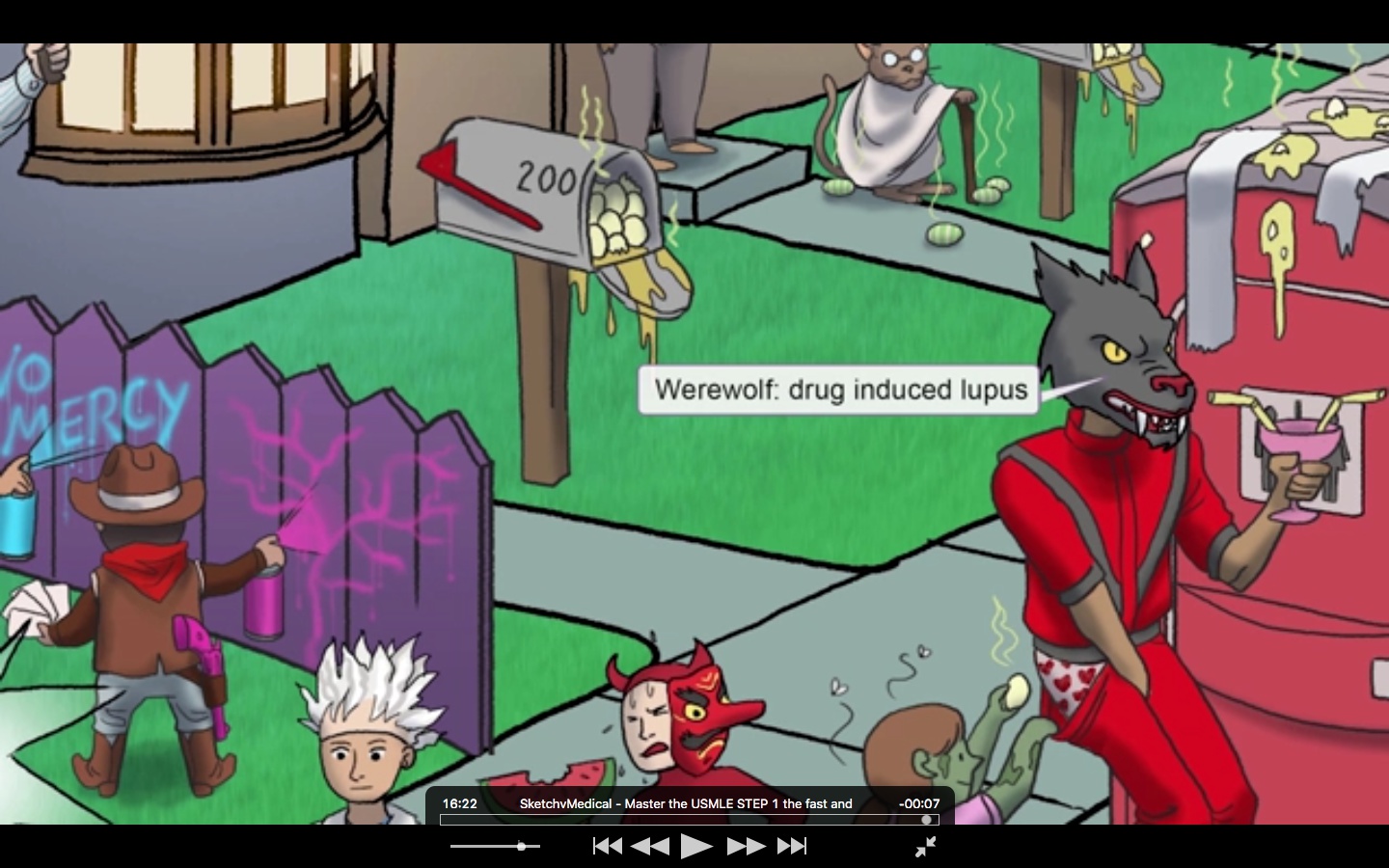

Ghandi cat: treat toxoplasmosis caused by Toxoplasma gondii
Dyed sulfur eggs: sulfadiazine
Pyramid witch hat: pyrimethamine. Good for malaria and toxoplasmosis because inhibits parasite DHFR
Fluoroquinones
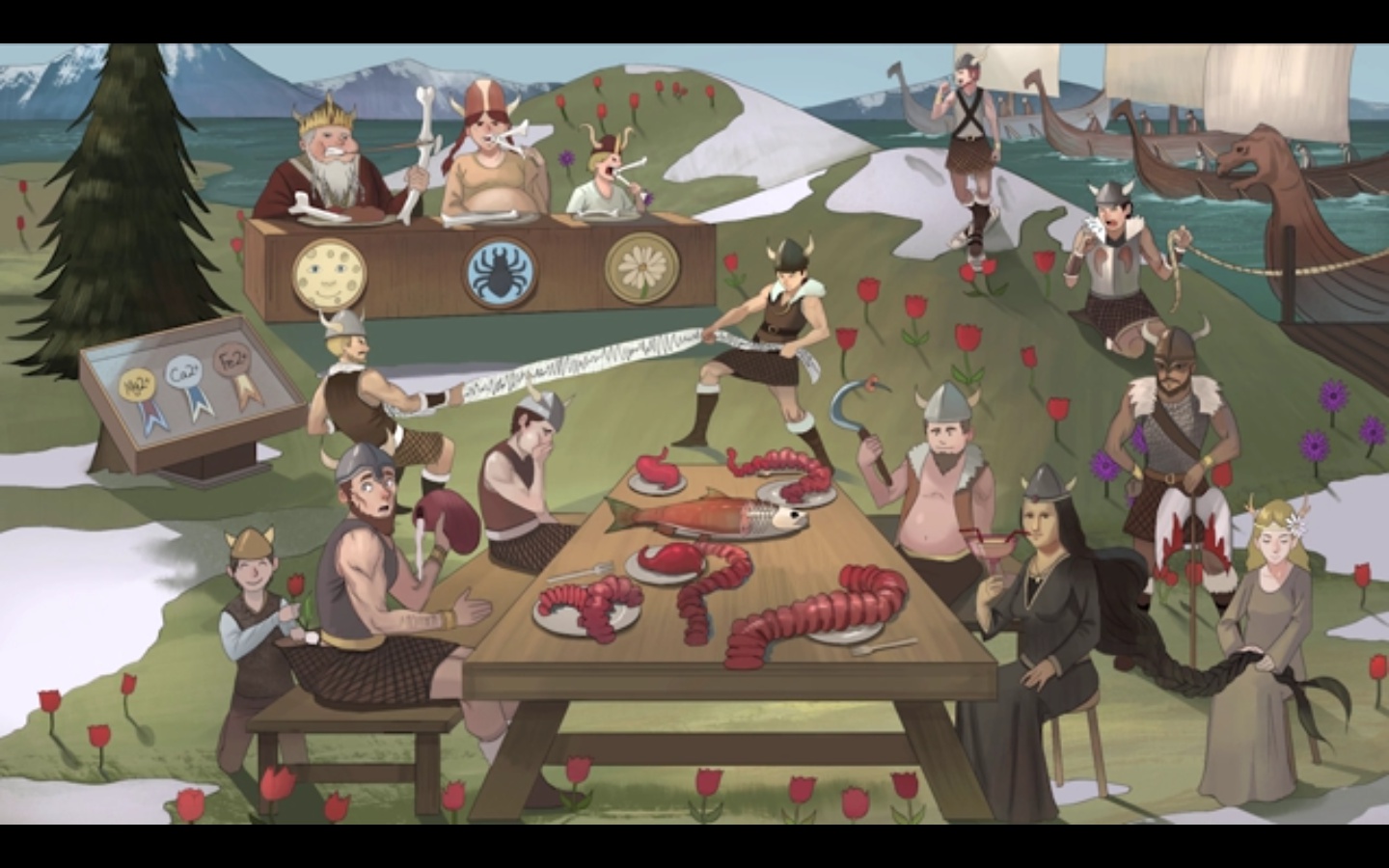
Flowers: fluoroquinolones
unwinding braid: inhibit bacterial topoisomerases (e.g. DNA gyrase)
bacterialcidal because inhibit transcription

Red bladder cup: treat gram negative UTIs (e.g. E. coli, Proteus)
Mona Lisa elevating and sipping from bladder cup: levofloxacin and ciprofloxacin treat UTI caused by Pseudomonas
Milky kidney flask: empiric treatment for pyelonephritis
Flower bulb down pants: treat acute prostatitis
Gastrointestinal feast: treat gram negative bacterial causes of gastroenteritis (e.g. Shigella, Salmonella, E. coli, Campylobacter
Salmon: treat Salmonella gastroenteritis
Fish bones: treat gram negative osteomyelitis
Sickle: sickle cell patients are at increased risk of Salmonella osteomyelitis
Lung axe: treat anthrax caused by Bacillus anthracis
Rusty chest plate: respiratory quinolones treat community acquired pneumonia (e.g. levofloxacin, moxifloxacin
Cold walking snowshoer: respiratory quinolones treat atypical “walking” pneumonia caused by Mycoplasma pneumoniae (e.g. levofloxacin, moxifloxacin)
Legion of ships: respiratory quinolones treat atypical “walking” pneumonia caused by Legionella pneumophila (e.g. levofloxacin, moxifloxacin)

Medals: divalent and trivalent cations (e.g. calcium, iron, magnesium) decrease absorption
Torsades strip: risk of prolonged Q-T interval
GI side effects, diarrhea
Old king gnawing on tendon: risk of tendon and cartilage damage in the elderly
Moon facies shield: risk of tendon and cartilage damage with chronic steroid use
Tarantula: teratogenic - damage to growing cartilage
Child gnawing cartilage: not recommended for children <10 years old - damage to growing cartilage
RIPE
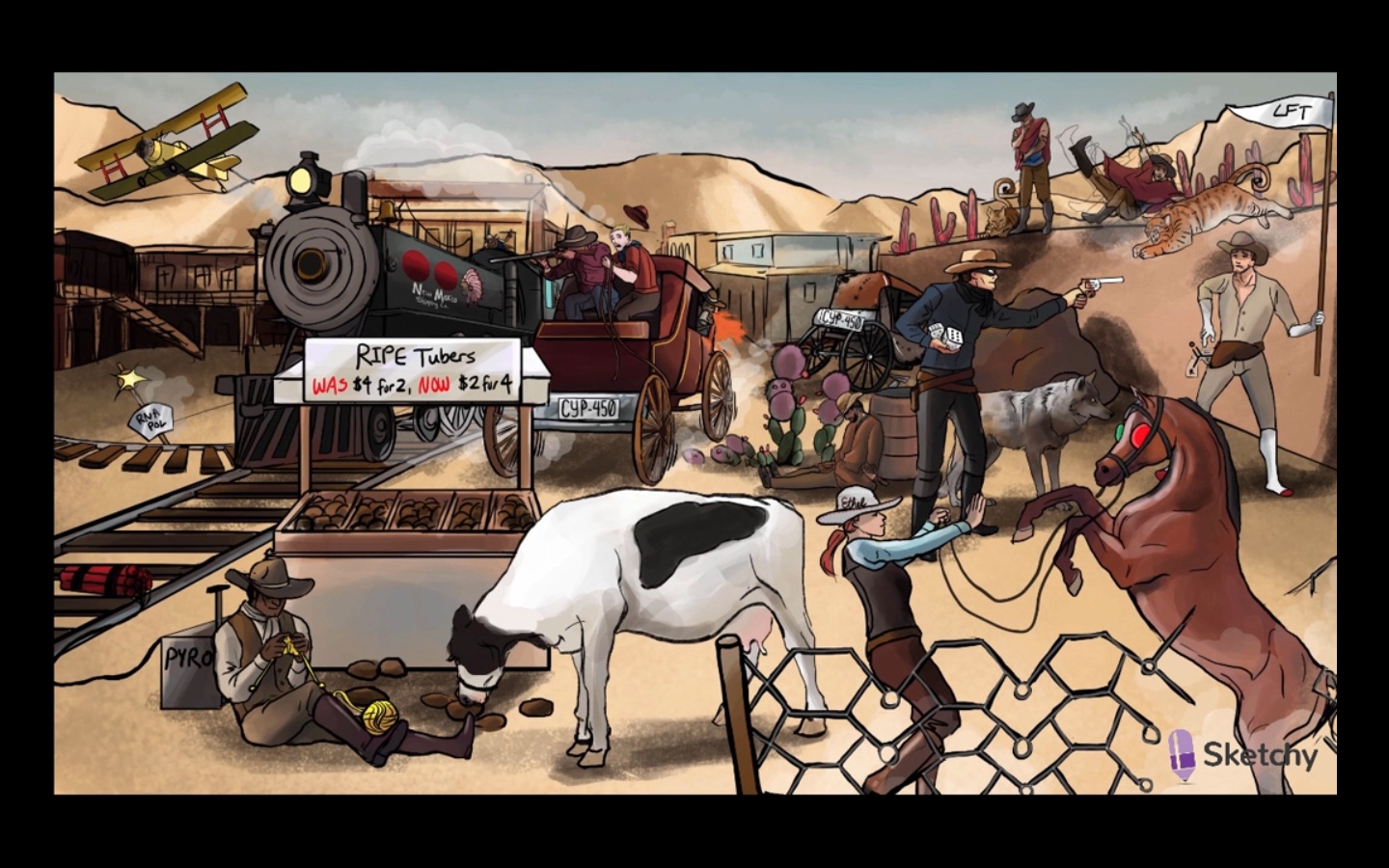
RIPE: Combination of rifampin, isoniazid, pyrazinamide, and ethambutol used to prevent development of resistance
2 phases of treatment: 4 drugs for 2 months followed by 2 drugs (i.e. isoniazid and rifampin) for 4 months
Liver spot: hepatotoxicity associated with all RIPE therapy drugs
INH

The Isolated Ranger: isoniazid (INH)
Mycobacteria cowboy shot off wall: INH acts on the mycobacterial cell wall by inhibiting mycolic acid production
Aggravating G tailed cat: INH is activated by a catalase-peroxidase (KatG)

Middle lobe bullet hole: primary TB (often presents as middle lobe cavity
Sleeping: INH can be used alone to treat latent TB infections

Silenced G tailed cat: resistance to INH by downregulating Kat G

Bandit in stockings and gloves: INH may cause peripheral neuropathy
Slow acetyl-gunslinger: INH metabolized by the liver enzyme N- acetyltransferase - slow acetylators have higher risk of side effects
Pair of dice (sixes): pyridoxine (vitamin B6) - INH promotes excretion
Ungloved hand holding dice: coadministration of INH and pyridoxine prevents peripheral neuropathy
Wolf: INH may cause drug induced lupus
MUD PILES: INH may cause anion gap metabolic acidosis
Broken chrome bumper: INH inhibits cytochrome P450
Motion lines: INH may cause seizures
Can also trigger hemolytic anemia in G6PD deficient patients
Rifampin

The Rifle: rifampin
Shot RNA track switch: rifampin binds bacterial DNA dependent RNA polymerase
Rifampin prophylactic monotherapy in close contacts exposed to Haemophilus influenzae or Neisseria meningitidis
Meningitis mohawk: Neisseria meningitidis
H plane: Haemophilus influenzae
Rifampin may produce orange body fluids
Speeding chrome bumper: rifampin activated cytochrome P450
Ethambutol

Ethel the Horse Whisperer: ethambutol
Arabian horse at the carbohydrate wall: ethambutol blocks arabinosyl transferase, inhibiting carbohydrate formation at the cell wall
Halt!: ethambutol is bacteriostatic
Red-green blinders: optic neuritis (loss of visual acuity, red-green color blindness)
Pyrazinamide

The Pyro: pyrazinamide
Needles: pyrazinamide may cause hyperuricemia and needle- shaped uric acid crystal formation
Yarn ball on toe: pyrazinamide may precipitate gout attacks
Leprosy
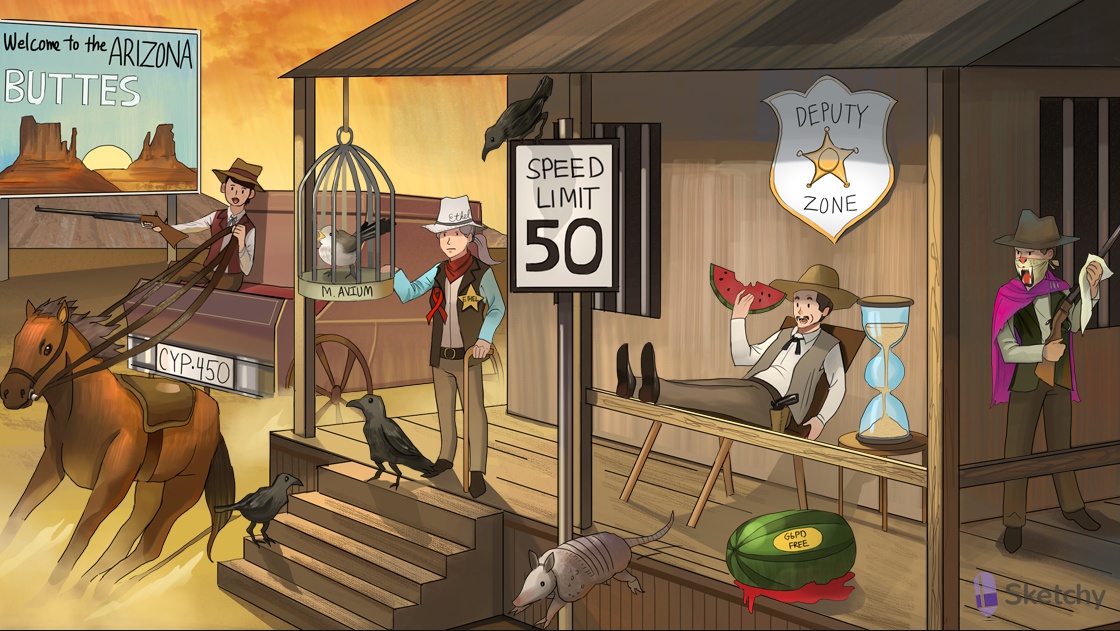
Immunocompromised cane: MAC is a common cause of disseminated disease in AIDS patients
Caged mockingbird: Mycobacterium avium complex (MAC) (Mycobacterium avium, Mycobacterium intracellulare)
crows: a macrolide (e.g. azithromycin or clarithromycin) combined with ethambutol treat MAC infections
Shariff Ethel: ethambutol (MAC treatment)
Speed limit 50: macrolide prophylaxis for MAC when CD4 < 50
Buttes: rifabutin (may be added as a third agent in treatment of MAC infection)
Rifle: rifampin (related to rifabutin)
Speeding chrome bumper: rifampin and rifabutin activate cytochrome P450; not as strong of an activator as driver brings cart to a halt

Leaping armadillo: Mycobacterium leprae(causative agent of leprosy)
Deputy zone: dapsone(used to treat leprosy)
Multi-lobed sand timer: dapsone can cause agranulocytosis and methemoglobinemia
Bite and seeds: bite cells and Heinz bodies seen in RBCs
Broken G6PD-free fruit: dapsone can cause hemolytic anemia in G6PD deficiency
Cloth: clofazimine (treats lepromatous leprosy)
Rifle: rifampin (used to treat leprosy)
Last updated
Was this helpful?